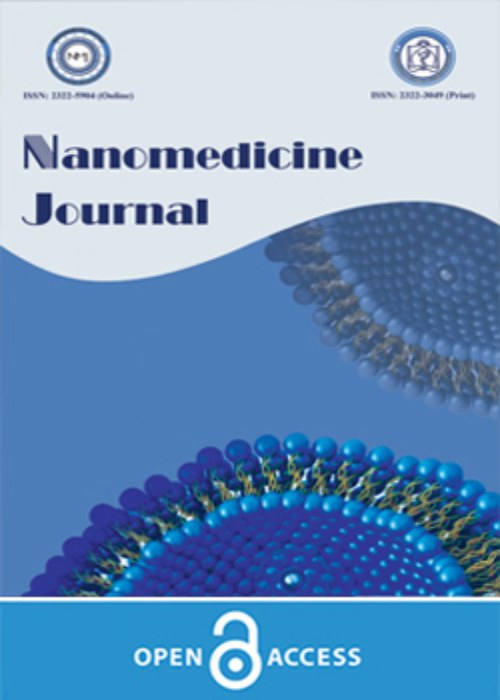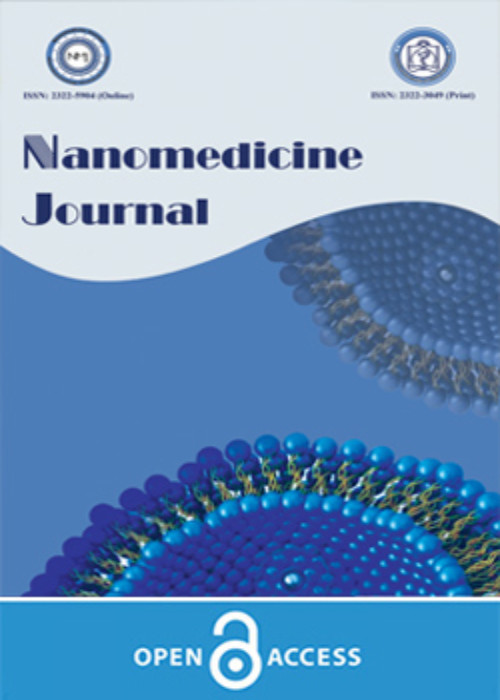فهرست مطالب

Nanomedicine Journal
Volume:10 Issue: 3, Summer 2023
- تاریخ انتشار: 1402/04/10
- تعداد عناوین: 9
-
-
Pages 163-170
Medicinal products of plant origin have long been considered the most affordable and accessible sources to treat different health problems. Bromelain (Br) is a mixture of enzymes derived from pineapple (Ananas comosus L.) with a wide field of applications including medicine, health, food, and cosmetics. Br has various therapeutic effects, such as antimicrobial, antioxidant, anticancer, wound healing, burn treatment, pain relief, anti-inflammatory, inhibition of platelet aggregation, and fibrinolytic activity. On the other hand, most proteins are susceptible to denaturation and structural changes that may reduce their activities. Encapsulation of drug molecules into nanoparticles (NPs) could increase their stability, bioavailability, and overcome other challenges in drug delivery and therapy. This review aimed to highlight various Br nano-formulations approaches, toward the improvement of Br therapeutic efficiency.
Keywords: Bromelain, Nanoparticles, Pineapple, Stability, Therapeutic application -
Pages 171-179
Micro ribonucleic acid (miRNA) is single-stranded RNAs that play a key role in gene regulation and development. The origin and precise activities of miRNAs have been uncovered in recent years, with an emphasis on their potential applications in the research field. Thus, miRNAs are promising diagnostic and prognostic biomarkers especially disease specific biomarker. Traditional methods for detection of miRNA lack sensitivity and specificity. Therefore, novel nanotechnology-based methods to detect microRNA have been developed. This literature review provides an overview of cutting edge nano approaches that have been used to identify distinct miRNA biomarkers. To date, no single or panel of miRNA marker has been developed for clinical application. Therefore, further research is needed on the detection of multiple miRNA biomarkers to diagnose various diseases at an early stage using nanotechnology.
Keywords: Biomarker, Circulating miRNA, MicroRNA, Nanosensors -
Pages 180-196
As one of the most well-known metal nanoparticles, gold nanoparticles (AuNPs) have attracted much attention for the biological applications. This great interest in AuNPs can be attributed to their outstanding physical and chemical properties, such as special optical and electrochemical characteristics, high X-ray attenuation ability, strong X-ray absorption, photothermal effect, stability and biocompatibility. In addition, due to the ease of synthesis and modification of the surface of AuNPs, it is possible to control their shape, size and surface characteristics. All these features suggest that AuNPs can be used for biosensing strategies, drug delivery, photothermal therapy, nanobrachytherapy, enhanced radiotherapy and CT imaging. In addition, they can be used as antibacterial and antifungal agents. This minireview focuses on the key principles, research achievements and new opportunities in the synthesis of AuNPs as well as their biological applications. In fact, the growing progress in the use of AuNPs for the diagnostic and therapeutic applications is described in this survey. Overall, a better understanding of the key aspects of the synthesis methodologies will lead to the development of new protocols that can provide ideas for more cost-effective and reliable approaches to the production of AuNPs.
Keywords: AuNPs, Diagnosis, Synthesis, Therapy -
Pages 197-209Objective(s)
Memory and cognition impairments are the most important secondary effects of spinal cord injury (SCI) in the hippocampus. Therefore, the present study aimed to examine the effect of implantation of polycaprolactone/ functionalized multiwall carbon nanotube (PCL/f-MWCNT) scaffold along with ellagic acid loaded liposome (EA@lip) in neurological function recovery and hippocampus deficit after SCI.
Materials and MethodsTwenty-four female Wistar rats were randomly assigned into 4 groups (n=6): Ctrl- group (laminectomy without SCI), Ctrl+ group (SCI), PCL/CNT group (implantation of PCL/f-MWCNT scaffold) and PCL/CNT/EA group (implantation of PCL/f-MWCNT/EA@lip scaffold). The injury model was the dorsal hemisection at the T9 level. Characterization of EA@lip made by remote loading method was done by transmission electron microscopy and dynamic light scattering. Also, the morphology of PCL/f-MWCNT fibers was investigated by field-emission scanning electron microscopy (FE-SEM). Behavioral tests were used to evaluate the neurobehavioral performance of the animals. After 4-weeks, excitatory postsynaptic potential was recorded from the CA1 area of the hippocampus. Hippocampal mRNA levels of amyloid beta precursor protein (APP), cyclic nucleotide phosphodiesterase (CNP), glutamate ionotropic receptor kainate type subunit 2 (GRIK2) and syntaxin-binding protein 1 (Munc 18-1) were assayed using reverse transcription-quantitative polymerase chain reaction (RT-qPCR).
ResultsWe demonstrated that, after implanting the PCL/CNT scaffold with or without EA@lip, the hippocampal action potential improved by increasing the slope and amplitude of fEPSP compared to the Ctrl+ group. RT-qPCR data showed that the expression of CNP and Munc 18-1 increased, and the expression of APP and GRIK2 decreased, in the groups that received PCL/CNT with or without EA@lip compared to the injury group. We also proved that the treatment with PCL/CNT/EA@lip improved behavioral performance compared to the Ctrl+ and PCL/CNT groups.
ConclusionThis study demonstrated that PCL/f-MWCNT/EA@lip scaffold implantation improves functional potential and alters the expression of memory-related genes in the hippocampus post-injury.
Keywords: Action potentials, Drug delivery systems, Memory, Neurogenesis, Tissue engineering -
Pages 210-215Objective (s)
Cancer is one of the most devastating diseases and ranks second in a total number of deaths caused globally. In recent years there is a steady increase in breast cancer (BC) incidence due to several etiological factors. Due to indiscriminate drug delivery and the lack of target specificity, current cancer therapies can cause life-threatening side effects. The present research emphasises targeting the rutin-loaded onto carbon nanotubes (CNTs) for breast cancer treatment. Further, rutin-loaded multi-walled carbon nanotube (MWCNT) and conjugated with folic acid is the focus of our research against breast cancer.
Materials and MethodsIntermolecular interaction studies between rutin (PubChem CID 5280805) and the target protein folate receptor (PDB ID 4LRH) via Autodock Vina programme and PyRx tool and molecular dynamics simulation studies were performed.
ResultsThe docking score was found to be -8.7 Kcal mol-1. In comparison, that of the standard chemotherapeutic drug 5-Fluorouracil was -5.9 Kcal mol-1. Molecular dynamic studies were performed via Desmond for 100ns. The root-mean-square deviation (RMSD) value of the ligand remained stable, root-mean-square fluctuation (RMSF) values have been observed to be stable throughout the simulation time.
ConclusionBased on these promising results, rutin-loaded CNTs can be further evaluated for their efficacy against breast cancer preclinically.
Keywords: Breast Cancer, Folate receptor, Molecular docking, Molecular dynamics, Rutin -
Pages 216-226Objective (s)
This study aimed to evaluate the viability of encapsulated probiotics using electrospinning technique. Specifically, the study focused on polyvinyl alcohol-whey protein isolate nanofibers (PVA/WPI) containing Bifidobacterium bifidum. These nanofibers have potential applications in active food packaging to improve food safety and extend shelf life, as well as in medical and pharmaceutical fields.
Materials and MethodsPVA/WPI nanofibers were electrospun in varying ratios (ranging from 100:00 to 50:50) and evaluated for their morphology, mechanical properties, FT-IR and DSC characteristics. B. bifidum was also encapsulated in the optimized PVA/WPI nanofibers to assess their encapsulation efficiency and viability, and the antimicrobial properties of the nanofibers were determined using the disk diffusion method.
ResultsAll prepared nanofibers displayed a diameter range of 186.42-612.5 nm, with an inverse relationship between WPI ratio and nanofiber diameter. The PVA/WPI nanofiber with a ratio of 60:40 was found to be the most favorable. DSC analysis showed that adding WPI decreased thermal stability, and the enthalpy of endothermic peaks decreased in nanofibers containing B. bifidum. Mechanical evaluation revealed that adding WPI reduced tensile strength and elongation at break, without significant effects from B. bifidum (P>0.05). Bacterial encapsulation efficiency was 80.58%. Probiotic nanofibers exhibited antimicrobial properties against Listeria monocytogenes (11.00±0.37 mm) and Escherichia coli (9.71±0.06 mm).
ConclusionAccording to the obtained results, the optimized PVA/WPI nanofiber (60:40) contained suitable morphological, mechanical and thermal characteristics with the highest encapsulation efficiency in regards to B. bifidum (>80%). Probiotics-containing PVA/WPI nanofibers are a suitable platform for medical applications and food industry packaging due to their antimicrobial properties.
Keywords: Antimicrobial activity, Bifidobacterium bifidum, Bioactive packaging, Nanofiber, Nanotechnology -
Pages 227-233Objective (s)
Aspergillus species are found as opportunistic agents to cause a wide variety of clinical manifestations. Regarding the drug resistance emergence against Aspergillus species, new aspects of using nanoparticles (NPs) as antifungal agents are considerable. This study takes a new approach to biosynthesized NPs of zinc oxide, copper oxide, cerium oxide, silver, gold, and selenium influence on the clinical isolates of Aspergillus species.
Materials and MethodsThe antifungal activities of six NPs were examined against a total of 12 clinical isolates of Aspergillus species, including A. flavus (n=4), A. welwitschiae (n= 4), and A. fumigatus (n=4) based on the M38-A2 guideline.
ResultsAccording to minimum inhibitory concentration (MIC) values, NPs of ZnO, Ag, Au, and Se showed a significant antifungal effect. CuO-NPs and CeO2-NPs didn’t show an inhibitory effect against Aspergillus isolates. The MIC ranges of ZnO-NPs, Ag-NPs, Au-NPs, and Se-NPs were 128-512, 26-53, 21-85, and 6-26 µg⁄mL for A. fumigatus; and 512->512, 26-53, 85, and 1-13 µg⁄mL for A. welwitschiae, respectively. In addition, the MIC ranges of Ag-NPs and Se-NPs were 26-53 and 106-425 µg⁄mL for A. flavus, respectively. However, A. flavus were not inhibited by NPs of ZnO and Au.
ConclusionAmong the examined NPs, ZnO, Ag, Au, and Se showed a significant effect against Aspergillus isolates except for CuO and CeO2. However, Ag-NPs seemed to be the most effective nanoparticle against the Aspergillus species. Compared to other Aspergillus species, A. flavus was not inhibited by NPs of ZnO and Au.
Keywords: Antifungal agents, Aspergillus, Clinical, Nanoparticles -
Pages 234-244Objective (s)
Encapsulation of essential oil in polymeric nanoparticles (NPs) increases their retention and improves their efficacy. Here, eucalyptus essential oil (EEO) encapsulate in the chitosan (CS) NPs increases its retention, and enhances the anticancer effect of EEO.
Materials and MethodsThe effects of pH, chitosan sodium tripolyphosphate ratio, and chitosan concentration on the size and charge NPs were evaluated. The success of EEO encapsulation was confirmed by FT-IR, UV–Vis spectroscopy, and GC techniques. The toxic effect of free EEO and CS-EEO NPs was investigated in MDA-MB-231 breast cancer cells and fibroblast normal cells.
ResultsThe optimized obtained EEO -loaded chitosan nanoparticles (CS-EEO NPs) were spherical with an average diameter of 86 nm, a polydispersity index below 0.4, and positive zeta potential (+14.25 mV) as confirmed. Increasing the concentration and pH of the chitosan solution and decreasing the chitosan/sodium tripolyphosphate ratio, the size of NPs decreased. Loading capacity (LC) and encapsulation efficiency (EE) of EEO in the NPs were about 45% and 32–76%, respectively. The chitosan nanoparticles exhibited a biphasic release profile with the release of 87% of the EEO in the first 5 h, followed by a sustained release for the next 43 h.
ConclusionThe free EEO was more toxic for MDA-MB-231 cells than fibroblast cells; however, CS-EEO NPs were non-toxic for fibroblast cells and more toxic for MDA-MB-231 cells compared to free EEO. Therefore, the CS-EEO NPs illustrate smart behavior in killing cancerous cells and will be suggested for breast cancer drug delivery.
Keywords: Chitosan nanoparticles, Eucalyptus essential oil, Encapsulation, MDA-MB-231 cells -
Pages 245-258Objective (s)
The study aimed to synthesize both silver- and zinc-oxide nanoparticles utilizing the Peganum harmala smoke extract (PHSE) bio-platform to evaluate their cytotoxicity on different types of human cancer cell lines and study their anti-oxidant, and anti-angiogenic potentials.
Materials and MethodsThe Silver (Ag) and zinc oxide (ZnO) nanoparticles (NP) were produced utilizing the green-synthesize method by applying the PHSE bio-platform. After characterization by X-Ray Diffraction (XRD), dynamic light scattering (DLS), Field emission scanning electron microscopy (FESEM), and Fourier-transform infrared spectroscopy (FTIR) methods. MTT assay was used for the evaluation toxicity of nanoparticles. ABTS, DPPH, FRAP, and ROS for anti-oxidant capacity, chicks’ chorioallantoic membrane (CAM), and qPCR for anti-angiogenesis effects of nanoparticles were used.
ResultsAg-NPs (82.42 nm) and ZnO-NPs (163.05 nm) inhibited prostate, ovarian, and liver malignant cells. Inhibition of ABTS•+ and DPPH•+ and increasing the rate of intracellular ROS exhibited the anti and pro-oxidant capacity of Ag and ZnO-NPs out and inside of malignant cells. Also, their anti-angiogenesis impact was verified by significant dose-dependent VEGF and VEGFR down-regulation and the decreased blood vessels in the CAM.
ConclusionThe anti-oxidant, cytotoxicity and anti-angiogenesis effects of Ag and ZnO-NPs synthesized from Pecan smoke extract make it possible to use these nanoparticles in cancer chemotherapy.
Keywords: Angiogenesis inhibitors, Anti-Oxidants, Metal Nanoparticles


